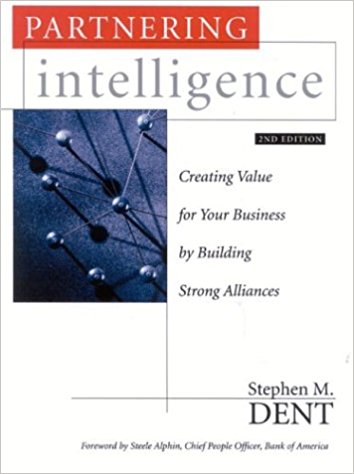Partnering Intelligence Summary

5 min read ⌚
 Creating Value for Your Business by Building Strong Alliances
Creating Value for Your Business by Building Strong Alliances
Partnerships have always existed. All throughout history, people lived in groups and societies for a variety of reasons and relied on each other. When the industrial revolution started, individualism developed, and the working environment got more fragmented.
Who Should Read “Partnering Intelligence”? And Why?
Many people believe that building partnerships depend on friendships, instincts and a touch of accounting. However, the ways to create a fruitful collaboration are more perplexing than that. In “Partnering Intelligence“, the author, Stephen M. Dent, specifies the qualities that make both inner and outer alliances useful.
This process includes understanding the phases of relationship creation and partnership development and turning towards a past/future orientation. The author explains how to evaluate, start and develop reliable connections, and offers outlines and checklists to guide you through each stage.
Furthermore, he presents a couple of case scenarios which illustrate the process of building strong partnerships. We recommend this book to readers who are thinking about creating a certain partnership or looking for ways to improve an already existent association.
About Stephen M. Dent
Stephen M. Dent is an award-winning organizational consultant. He is the co-founder of The Partnership Continuum.
He participates in workshops, speeches, and has trained numerous executives, managers, and consultants, during his nearly 20 years of experience.
“Partnering Intelligence Summary”
In the information era, in which we live nowadays, creating partnerships is necessary for survival. Most entrepreneurs do not have what it takes to work alone it in profoundly competitive and specialized markets.
Thus, at present, you need to collaborate with others like never before. However, being able to create and cultivate partnerships is a skill. Hence, just like with any other talent and ability, some people and organizations are better at it than others.
This ability can be quantified as an IQ score, which expresses mental intelligence. Those with high IQ scores, for the most part, do well at assignments that utilize their cognitive aptitudes. Furthermore, there is different sorts of intelligence, for example, emotional, spatial, linguistic, kinesthetic and musical intelligence.
You need collaborating knowledge to prevail in partnerships. Your PQ (partnering quotient), shows how well you can succeed in an association with some other person or other organization. PQ is not a natural ability – you can learn it and work on increasing it.
You can approach learning PQ by firstly becoming self-aware. This is the establishment of a solid partnership since you have to understand your own needs, to have the capacity to distinguish and fulfill your partner’s needs and wants. Start developing your partnering skills, utilizing the “Partnership Continuum.”
The Partnership Continuum is a well-ordered structure that can enable you to accomplish a full partnership. This model encourages you to work on the two essential segments – tasks and relationship, which you need for a fruitful association.
As you handle these two layers and build a partnership, you will realize that the relationship depends on trust and mutual benefit.
As you enter and cultivate your partnership, practice the PDCA or the plan-do-check-act cycle, which will allow you to develop continually. If you realize that your union is not working for some reason, you can go to the “Abandon” stage.
On the off chance that you are having issues, relinquish the partnership early on, so you do not put excessive time, energy and funds in it. Four parts consist the PDCA cycle. In the Plan part, you should decide what moves to make to achieve a particular task or discuss the essential components of the relationship.
The Do part is reserved for carrying out the arrangement and taking action. Decide, take part in critical thinking and impart as you arranged. In the check part, analyze whether you carried out the plan as you imagined and whether both the undertaking and relationship wound up as you wished.
Finally, in the Act part look for approaches to additionally enhance your activities and improve. Put the PDCA cycle into action, as you experience each stage.
Key Lessons from “Partnering Intelligence”
1. Important Partnerships
2. Assessing Your Partnership Abilities
3. The Partnership Continuum
Important Partnerships
As we already mentioned, partnerships are essential for development and survival. When you pick a business partner, imagine that you are someone who is dating and trying to find a partner and to develop a profound connection and relationship.
Good relationships are critical to any successful business since business relies upon cooperation, not just transactions.
Assessing Your Partnership Abilities
Partnerships can be external (with other companies) and internal (connections within the organization). Albeit most businesses rarely perceive these associations between the organization and its employees, these are the primary business partnerships.
To make a decent relationship with a partner, evaluate your PQ, or, in other words, assess if your company possesses the qualities required for a proper partnership.
You need to learn your PQ since the process of having a good partnership depends on your character.
The Partnership Continuum
Partnerships do not naturally happen – they should be created. The Partnership Continuum Model is a tool which will create the proper climate to openly talk about the processes of forming a partnership and will advance better correspondence and trust. This Partnership Continuum Model has three segments:
Stage 1: Relationship Development – Forming, Storming, Norming, Performing
Stage 2: Partnership Development – Assessing, Exploring, Initiating, Committing
Stage 3: The Past/Future Orientation Environment
To make your partnership work you need to go through all segments of the Continuum.
Like this summary? We’d like to invite you to download our free 12 min app, for more amazing summaries and audiobooks.








